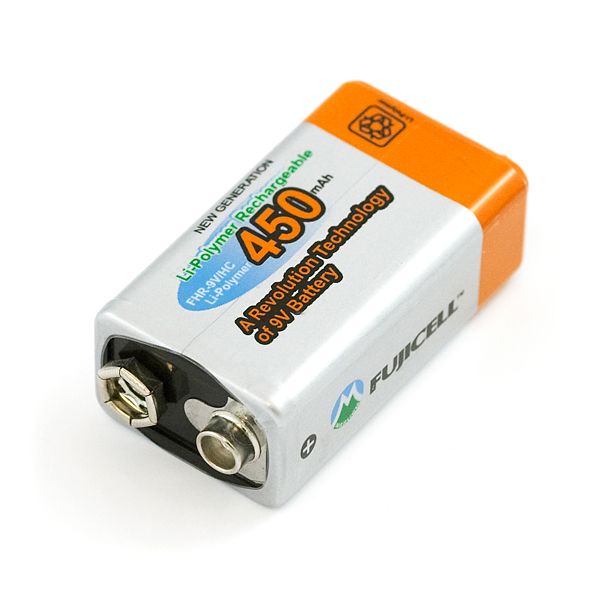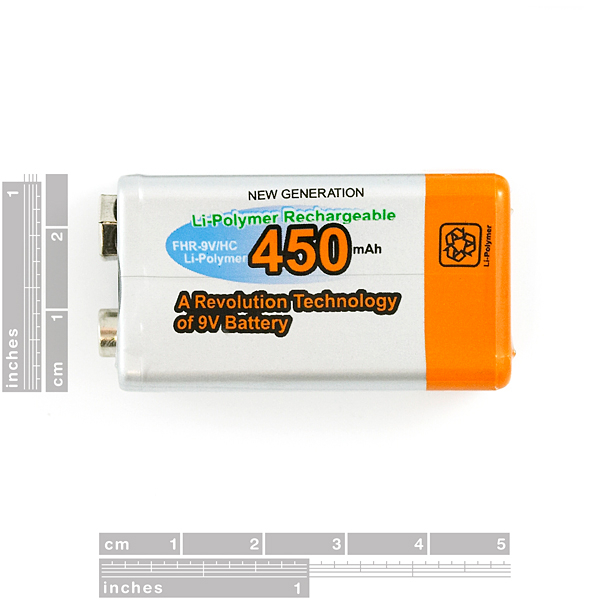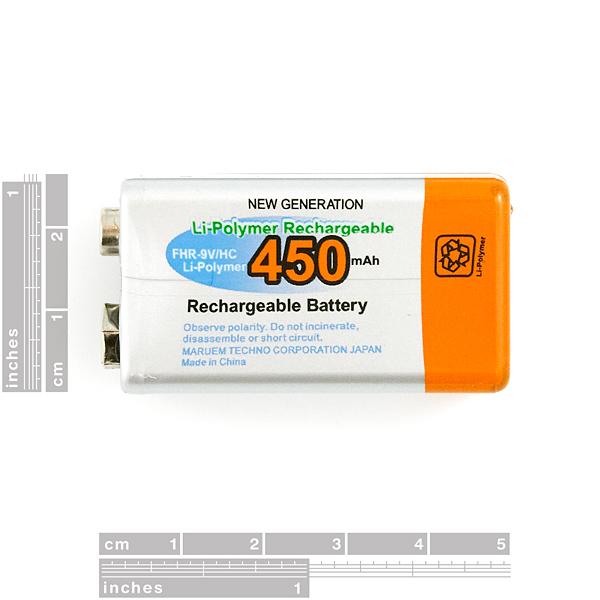9V Li-Poly Rechargeable Battery
Replacement: Although there is no direct replacement, we do carry a Li-ion rechargeable battery which could be a good substitute. This page is for reference only.
Now you can recharge those 9V batteries! Rechargeable 9v, 450 mAh Li-Polymer battery. This is a very unique rechargeable LiPo with a very high 450mAh rating! Most 9Vs are alkaline or Ni-Cd with much lower capacities.
Note: Do not use a standard Ni-MH or Ni-Cd charger. This battery requires special charging.
Comments
Looking for answers to technical questions?
We welcome your comments and suggestions below. However, if you are looking for solutions to technical questions please see our Technical Assistance page.
Customer Reviews
No reviews yet.




I can confirm after dissection that these batteries are two Lithium Polymer cells in series. It also appears that there is no integrated buck-boost converter or anything. There does however appear to be some basic safety circuitry.
You will only get 8.4 Volts for this battery for a brief period of time, however most voltage regulators won't care.
These batteries should be fairly safe since the hard plastic case should prevent the lithium from reacting with the air if the cell ruptures. However if the batteries become bloated or puffy I would suggest you stop using them.
http://www.iheartrobotics.com/2009/04/revolution-technology-of-9v-battery.html
As I write this, the combo charger is out of stock. What can I use (a specific item number, not generic XYZ charger) to charge these safely, or when is the combo charger going to be back in stock.
I won't claim to know how it works inside, but the open circuit voltage is 8.5V. I think it has some kind of current protection built in as well. I put my ammeter probes on it directly and it registers about 2A for a second then cuts off.
A datasheet on these things would be nice. I'd love to know the max current draw and details of any protection/voltage regulation circuit that might live in there.
They are very light compared to alkaline. I have more testing to do, but I think these will make nice batteries for my rocket electronics. :)
Guys,
A LiPo element is 3.7V. How could you build a 9V or 8.4V battery...?
This should be 7.4V or 11.1V. Probably 7.4V because of the (relatively) high capacity and small size.
I suppose the old school test of putting the terminals on your tongue as a quick check for voltage level is out with these guys pumping 450mah. Wow!
The mAh rating of the battery would not significantly affect the "tongue test". Besides, a quality alkaline 9V battery will have a similar mAh rating.
Let me put my nerd hat on for a moment. A circuit that consists of two components - a battery and a tongue - will have a limited number of factors to consider. For simplicity, let us assume that the tongue can be modeled by some resistance and capacitance.
A simple battery model may consist of its nominal open-circuit voltage (8.4V, or so); its source impedance (probably < 1 ohm); and its ampacity (450mAh).
The ampacity will only be a factor when determining how long the battery will be able to adequately source your tongue circuit. The source impedance will limit the peak current and reduce actual output voltage. I have already lost interest, so we'll skip the second-order effects. All of this talk about cooking tongue has me hungry for lunch.
These batteries sound extremely dangerous to me! Just google LIPO batteries and you'll see what I mean. I found many vendors you can buy these from but they all have some serious warnings. Some even require you sign a release form before buying. There are many youtube videos showing these things exploding. Granted, there is no documentation in the videos that I saw that talk about the charging current being applied during the explosions, but these are very impressive hot flaming events! Good ol' NiMH is what I'll stick with!!
There is no reason to panic with these batteries - I charge much larger LiPo batteries for my RC helicopter with no problem. You just need to use a LiPo approved charger, and learn what is the maximum voltage and current you can charge them at (probably 9v @ 450mAh, but follow any provided directions).
Do these get up to 9V or are they closer to the 8.4V we'd expect from two li-po cells in series?
Should be 8.4V